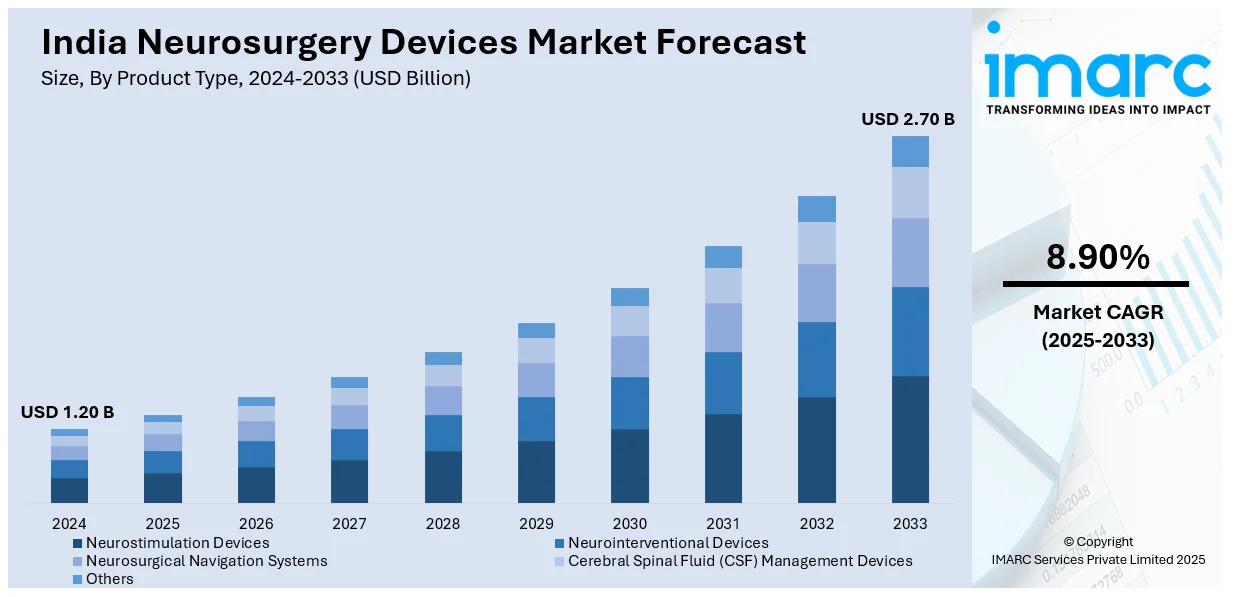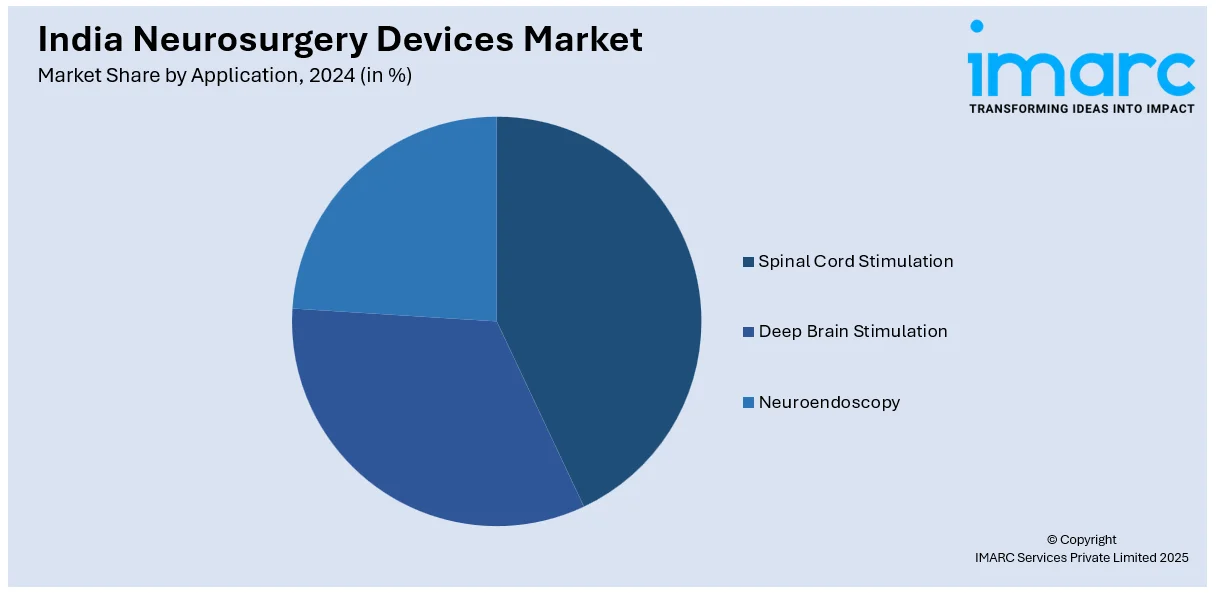
Neurosurgery Devices Market Report by Product Type (Neurostimulation Devices, Neurointerventional Devices, Neurosurgical Navigation Systems, Cerebral Spinal Fluid (CSF) Management Devices, and Others), Application (Spinal Cord Stimulation, Deep Brain Stimulation, Neuroendoscopy), End-User (Hospitals, Ambulatory Surgical Centers, and Others), and Region 2025-2033
Market Overview:
The global neurosurgery devices market size reached USD 12.9 Billion in 2024. Looking forward, IMARC Group expects the market to reach USD 32.7 Billion by 2033, exhibiting a growth rate (CAGR) of 10.37% during 2025-2033.
|
Report Attribute
|
Key Statistics
|
|---|---|
|
Base Year
|
2024
|
|
Forecast Years
|
2025-2033
|
|
Historical Years
|
2019-2024
|
|
Market Size in 2024
|
USD 12.9 Billion |
|
Market Forecast in 2033
|
USD 32.7 Billion |
| Market Growth Rate 2025-2033 | 10.37% |
Neurosurgery devices refer to various tools and instruments that are used for conducting surgeries and treating various pathologies in the central and peripheral nervous systems. They are primarily used for diagnosing, preventing and treating conditions such as Parkinson’s, Alzheimer’s, depression, epilepsy and traumatic brain and spinal cord injury. Some of the commonly used devices include neurostimulation devices, neurosurgical navigation devices and cerebrospinal fluid (CSF) management devices, such as curettes, dissectors, elevators and rongeurs. These tools aid in conducting microsurgeries, discectomies, elevating the periosteum below temporalis muscle and adjusting the skull bone during surgeries.

The increasing prevalence of various neurological disorders across the globe is one of the key factors driving the growth of the market. Furthermore, the rising geriatric population, which is more susceptible to neurological and other medical ailments, is also providing a boost to the market growth. There is also an increasing health consciousness and awareness among the masses regarding the availability of effective treatment alternatives for neurological disorders, which is contributing to the market growth. Consequently, there is a growing preference for neuroendoscopy surgeries over traditional brain surgeries. For instance, various neurostimulation devices are used to send electrical impulses to the targeted sacral nerves and perform deep brain stimulation. Additionally, various technological advancements, including the development of innovative minimally invasive (MI) equipment, such as flow diversion, liquid embolic and clot retrieval devices, neuroendovascular stents and balloon catheters, are acting as another growth-inducing factor. Other factors, including improvements in the healthcare infrastructure, along with extensive research and development (R&D) activities, are projected to drive the market further.
Key Market Segmentation:
IMARC Group provides an analysis of the key trends in each sub-segment of the global neurosurgery devices market report, along with forecasts at the global, regional and country level from 2025-2033. Our report has categorized the market based on product type, application and end-user.
Breakup by Product Type:
- Neurostimulation Devices
- Neurointerventional Devices
- Neurosurgical Navigation Systems
- Cerebral Spinal Fluid (CSF) Management Devices
- Others
Breakup by Application:

- Spinal Cord Stimulation
- Chronic Pain
- Failed Back Surgery Syndrome
- Ischemia
- Deep Brain Stimulation
- Parkinson's Disease
- Tremor
- Depression
- Others
- Neuroendoscopy
- Transnasal Neuroendoscopy
- Intraventricular Neuroendoscopy
- Transcranial Neuroendoscopy
Breakup by End-User:
- Hospitals
- Ambulatory Surgical Centers
- Others
Breakup by Region:
- North America
- United States
- Canada
- Asia Pacific
- China
- Japan
- India
- South Korea
- Australia
- Indonesia
- Others
- Europe
- Germany
- France
- United Kingdom
- Italy
- Spain
- Russia
- Others
- Latin America
- Brazil
- Mexico
- Others
- Middle East and Africa
Competitive Landscape:
The report has also analysed the competitive landscape of the market with some of the key players being Abbott Laboratories, Ackermann Instrumente GmbH, Adeor Medical AG, B. Braun Melsungen AG, Biotronik, Boston Scientific Corporation, DePuy Synthes Inc., Integra LifeSciences Corporation, Johnson & Johnson Services Inc., Medtronic Plc, Nevro Corporation, Nihon Kohden Corporation, Penumbra Inc., Stryker Corporation, etc.
Report Coverage:
| Report Features | Details |
|---|---|
| Base Year of the Analysis | 2024 |
| Historical Period | 2019-2024 |
| Forecast Period | 2025-2033 |
| Units | Billion USD |
| Segment Coverage | Product Type, Application, End-User, Region |
| Region Covered | Asia Pacific, Europe, North America, Latin America, Middle East and Africa |
| Countries Covered | United States, Canada, Germany, France, United Kingdom, Italy, Spain, Russia, China, Japan, India, South Korea, Australia, Indonesia, Brazil, Mexico |
| Companies Covered | Abbott Laboratories, Ackermann Instrumente GmbH, Adeor Medical AG, B. Braun Melsungen AG, Biotronik, Boston Scientific Corporation, DePuy Synthes Inc., Integra LifeSciences Corporation, Johnson & Johnson Services Inc., Medtronic Plc, Nevro Corporation, Nihon Kohden Corporation, Penumbra Inc. and Stryker Corporation |
| Customization Scope | 10% Free Customization |
| Post-Sale Analyst Support | 10-12 Weeks |
| Delivery Format | PDF and Excel through Email (We can also provide the editable version of the report in PPT/Word format on special request) |
Key Questions Answered in This Report:
- How has the global neurosurgery devices market performed so far and how will it perform in the coming years?
- What are the key regional markets?
- What has been the impact of COVID-19 on the global neurosurgery devices market?
- What is the breakup of the market based on the product type?
- What is the breakup of the market based on the application?
- What is the breakup of the market based on the end-user?
- What are the various stages in the value chain of the industry?
- What are the key driving factors and challenges in the industry?
- What is the structure of the global neurosurgery devices market and who are the key players?
- What is the degree of competition in the industry?
Need more help?
- Speak to our experienced analysts for insights on the current market scenarios.
- Include additional segments and countries to customize the report as per your requirement.
- Gain an unparalleled competitive advantage in your domain by understanding how to utilize the report and positively impacting your operations and revenue.
- For further assistance, please connect with our analysts.
 Request Customization
Request Customization
 Speak to an Analyst
Speak to an Analyst
 Request Brochure
Request Brochure
 Inquire Before Buying
Inquire Before Buying




.webp)




.webp)












